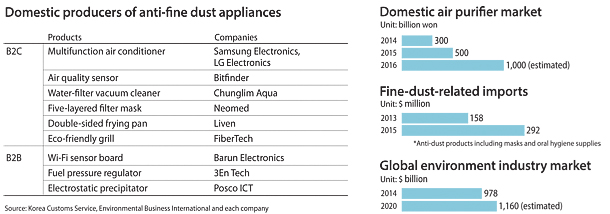Appliance makers combat fine-dust pollution

According to an industry insider, the domestic air purifier market jumped from around 300 billion won ($263.2 million) in 2014 to a whopping 500 billion won just last year. Concerns about pollution are driving both business-to-consumer (B2C) and business-to-business (B2B) manufacturers to expand into the so-called dust market segment with appliances that filter out unhealthy particles.
For example, aside from their traditional cooling function, Samsung Electronics’ so-called breeze-free air conditioner and rival LG’s Whisen Dual air conditioner also filter out ultra-fine dust with automatic sensors.
“Some 100,000 Q9500 breeze-free air conditioners were sold between January and June this year,” a Samsung spokesperson said. “This is 2.4 times more than sales of other premium air conditioners during the same period last year.”
Start-ups have also squeezed into the anti-dust market.
Korean venture Bitfinder, founded in 2014, launched a smart air sensor called Awair early this year. The clock-size device alerts residents of indoor air quality based on lifestyle details such as sleep hours and allergies.
“This product can improve life quality by measuring in real-time the fine-dust level of each household,” Bitfinder CEO Ro Bum-joon said. “With the function, you can even decide whether to leave the door open or closed when sleeping and calculate how much dust is produced while cooking.” The product can also be incorporated into automated home systems and has been exported to the North American region.
Chunglim Aqua, another local start-up, developed anti-dust technology using the physical properties of water. Its vacuum cleaner dissolves fine-dust particles that are absorbed in a mounted water filter. Ever since the product’s launch in 2008, some 600,000 units have been sold so far, and its sales growth this year has reached up to 50 percent.
“One day, I looked up at the sky after the rain,” Kim Hyeon-joo, CEO of Chunglim Aqua, said. “That was when I got inspiration for the vacuum cleaner with water filters.”
Concerns about dust have extended even to the kitchen, when the Ministry of Environment back in May said that frying mackerel, a popular fish for Koreans, makes dust concentration indoors higher than outdoors.
Although the ministry later attempted to quell citizens’ concerns amid outrage from fishermen that the mackerel industry was hurt by the announcement, consumers sought anti-dust cookware just to be sure.
Liven, a small cookware maker, received call after call inquiring about its double-sided, anti-dust frying pan that burns away particulate matters through small holes and marble-like dents on its side.
Another company, FiberTech, said it will release its eco-friendly Braten grill today. The product prevents the release of particulate matters using cutting-edge fusion metal technology.
Fine-dust-related items are also a focus in the B2B sector.
Posco ICT exports electrostatic precipitators that reduce particulate matter emissions at industrial sites. The company signed 70 construction contracts with China this year, as Beijing strengthened the fine-dust emission limit from 40 micrograms per cubic meter to 20.
Barun Electronics and 3En Tech have each developed Wi-Fi sensor boards and fuel pressure regulators that can measure levels of fine dust in the air and adjust emissions.
According to Environment Business International, the global environment market size will increase from $978 billion in 2014 to $1.16 trillion by 2020. The Internet of Things, it says, will be a main driver.
“In emerging markets like China, demand for environment-related goods will increase, so this should be the main target of corporations,” said a researcher at the Korea Institute of Energy Research.
Between 2000 and 2013, the average yearly market growth rate of the environment industry in emerging markets was 7 percent, far higher than the global 2.7 percent.
BY LEE CHANG-KYUN [lee.dongeun@joongang.co.kr]










with the Korea JoongAng Daily
To write comments, please log in to one of the accounts.
Standards Board Policy (0/250자)